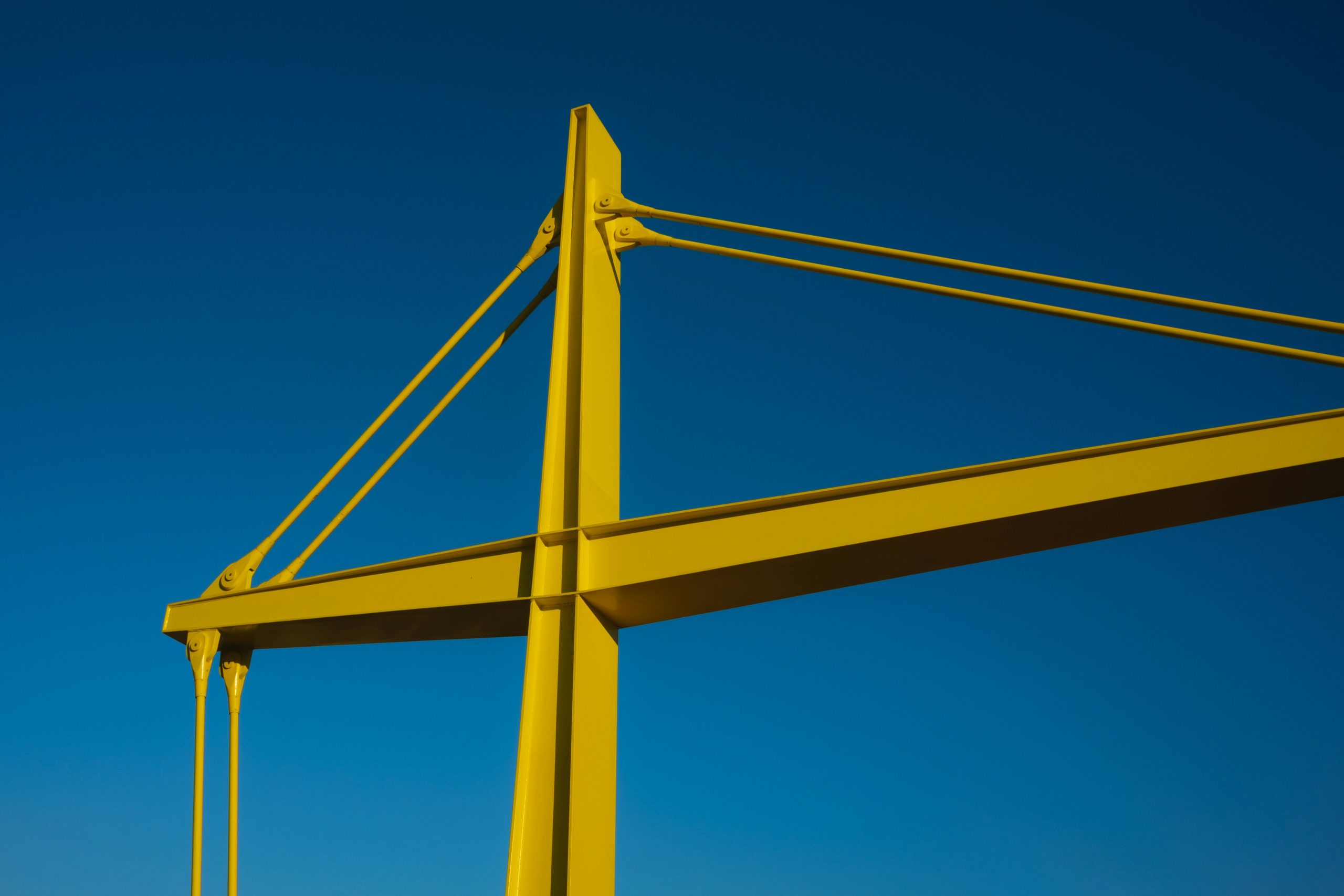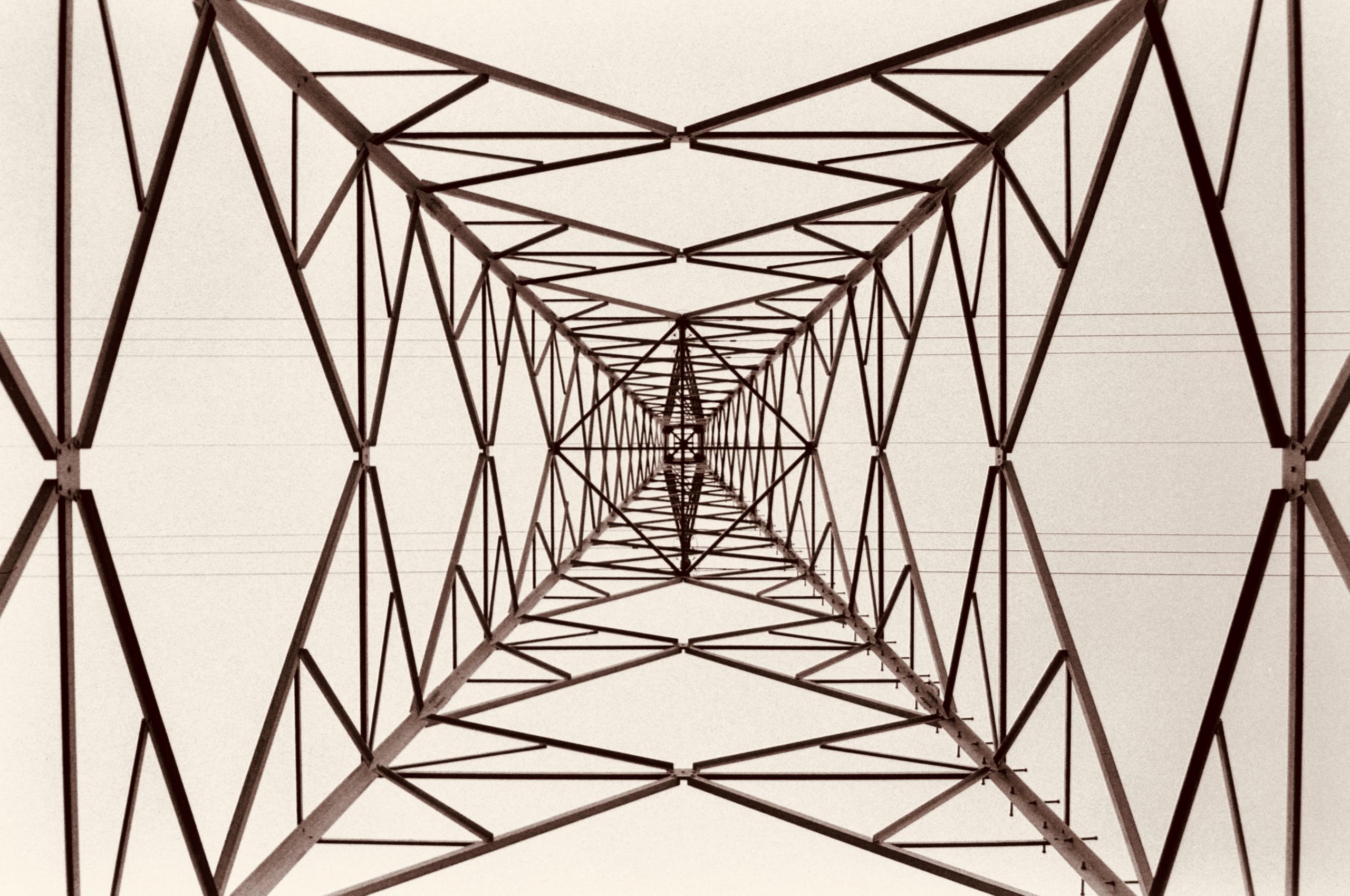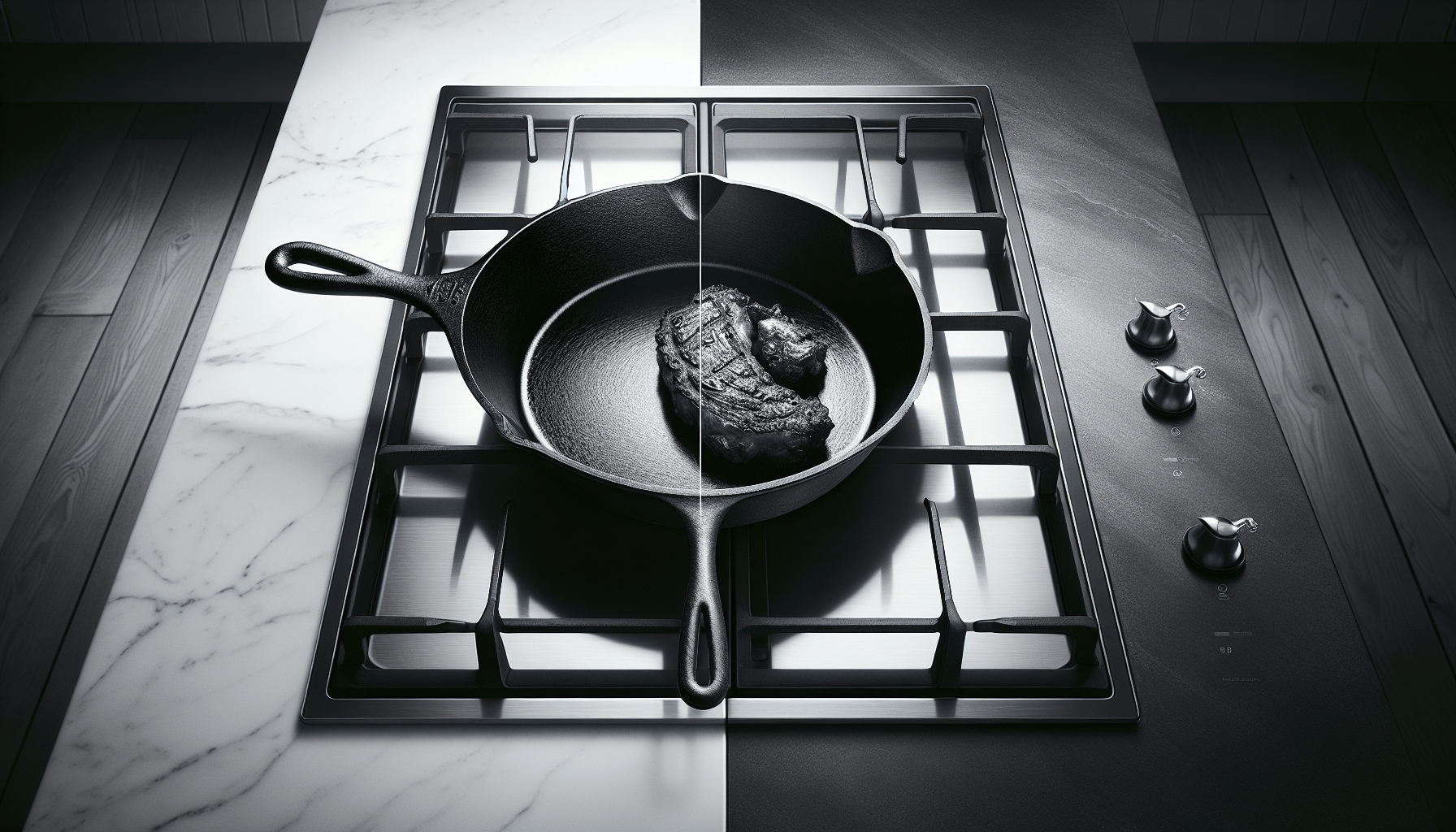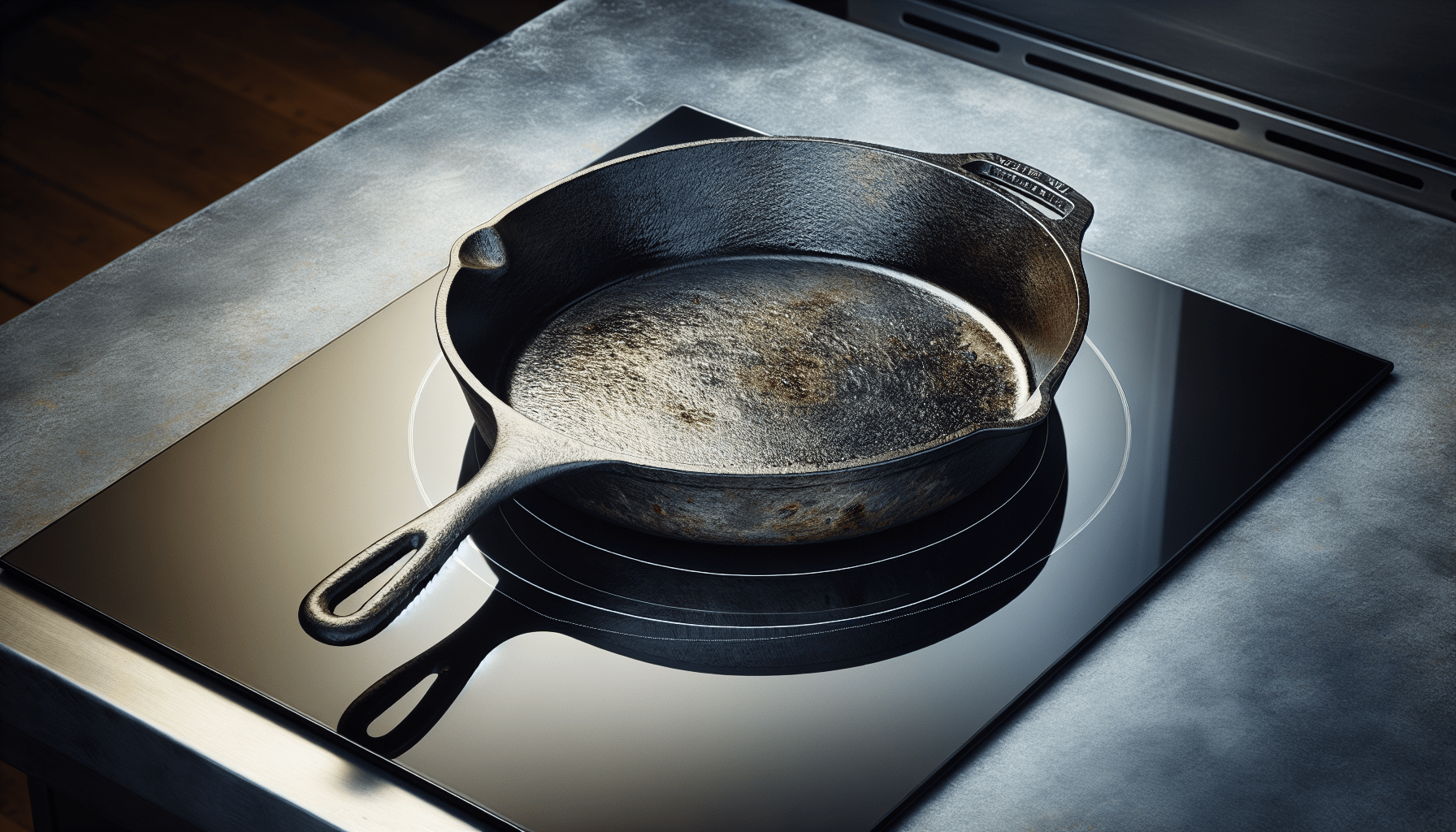If you have a glass-top stove and a beloved cast iron skillet, you may wonder if the two can coexist in your kitchen. The answer might surprise you! While many sources advise against using cast iron on glass-top stoves, the truth is that it can be done with some precautions. In this article, we will explore the practicality and considerations of using cast iron cookware on a glass-top stove, debunking any myths and offering helpful tips along the way. So, if you’ve been eager to whip up some delicious meals with your cast iron on your glass-top stove, read on to find out how you can make it work safely and effectively.
What is a glass-top stove?
Definition of a glass-top stove
A glass-top stove, also known as a ceramic cooktop, is a type of stove with a smooth glass surface that is used for cooking. It consists of a flat, ceramic glass panel with heating elements underneath. These heating elements are activated by electric power, providing heat to cook food. Glass-top stoves are popular for their sleek and modern appearance, as well as their ease of cleaning.
How does a glass-top stove work?
Glass-top stoves work by utilizing radiant heat to cook food. Beneath the smooth glass surface, there are electric heating elements that generate heat. When the stove is turned on and a specific temperature is set, the elements heat up and transfer the heat to the glass surface. The glass then radiates the heat evenly, providing a consistent and controlled cooking environment. This radiant heat allows for precise temperature control, making it easier to cook delicate dishes or simmer sauces without the risk of overheating.
Advantages of using a glass-top stove
Using a glass-top stove offers several advantages. Firstly, the smooth glass surface is easy to clean. Unlike traditional coil burners, there are no nooks or crannies where food and spills can get trapped. With a simple wipe-down, the glass surface can be kept clean and free of residue. Additionally, the even heat distribution of a glass-top stove helps to prevent hot spots and allows for more precise cooking. The sleek and modern appearance of a glass-top stove also adds a touch of elegance to any kitchen. Lastly, glass-top stoves are generally more energy-efficient compared to other types of stoves, as the heat is directly transferred to the cookware instead of being wasted in the air.
What is cast iron cookware?
Definition of cast iron cookware
Cast iron cookware refers to a range of cooking vessels made entirely or partially from cast iron material. It is known for its durability, heat retention capabilities, and versatility in the kitchen. Cast iron cookware can include items such as skillets, griddles, Dutch ovens, and frying pans.
Benefits of using cast iron cookware
Using cast iron cookware provides numerous benefits in the kitchen. One of the main advantages is its superior heat retention. Cast iron has the ability to absorb and hold heat for a longer period of time, allowing for even and consistent cooking. This makes it ideal for dishes that require steady, prolonged heat, such as slow-cooked stews or braises. Cast iron cookware also has excellent heat distribution, ensuring that food is cooked evenly throughout. Furthermore, cast iron is incredibly durable and can withstand high cooking temperatures, making it suitable for a variety of cooking methods, including stovetop, oven, and even outdoor cooking. Lastly, the naturally non-stick surface of well-seasoned cast iron cookware makes it easy to release food and simplifies the cleaning process.
Types of cast iron cookware
Cast iron cookware comes in various shapes and sizes, each designed for specific cooking purposes. Some common types include:
-
Skillets: These are the most commonly used cast iron cookware items. Skillets have a flat bottom and slightly curved sides, making them versatile for frying, sautéing, and baking.
-
Dutch ovens: Dutch ovens are deep, heavy pots with tight-fitting lids. They are perfect for slow cooking, braising, and making soups or stews.
-
Griddles: Griddles have a flat and smooth surface, making them ideal for cooking pancakes, eggs, and other delicate foods that require even heating.
-
Grill pans: Grill pans have raised ridges that mimic the grilling effect of an outdoor grill. They are great for achieving those classic grill marks on meats and vegetables.

Compatibility of cast iron cookware with glass-top stoves
General guidelines for using cookware on a glass-top stove
When using any type of cookware on a glass-top stove, it is important to follow some general guidelines to prevent damage to both the cookware and the stove. Firstly, ensure that the base of the cookware is flat and smooth, as uneven or rough surfaces can scratch or even crack the glass surface. Additionally, avoid dragging or sliding the cookware across the glass, as this can cause scratches. It is also important to use cookware that is suitable for the specific heat capacity of the glass-top stove. Finally, always handle the cookware with care to prevent accidental drops or impacts.
Factors to consider when using cast iron on a glass-top stove
While cast iron cookware is generally compatible with glass-top stoves, there are some factors to consider to ensure safe and effective use. The weight of cast iron cookware can be quite heavy, so it is essential to check the weight and size limitations of the specific glass-top stove model. Some stoves have weight restrictions to prevent damage to the glass surface. Additionally, the rough underside of cast iron cookware can potentially scratch the glass surface. Therefore, it is crucial to use caution when placing the cookware on the stove and avoid sliding or dragging it.
Risks and precautions of using cast iron on a glass-top stove
Using cast iron cookware on a glass-top stove does come with a few risks and precautions. The weight of the cookware can cause stress on the glass surface, leading to potential cracking or even shattering. This risk can be minimized by using cookware within the weight limitations specified by the stove manufacturer. Another concern is the potential for scratching the glass surface. It is important to inspect the cookware for any rough patches or large burrs that could scratch the glass. Additionally, avoid using excessive force or dropping the cookware onto the glass surface. Proper handling and care can greatly reduce the risk of damage.
Advantages of using cast iron cookware on a glass-top stove
Even heat distribution
One of the advantages of using cast iron cookware on a glass-top stove is its ability to provide consistent and even heat distribution. Cast iron has excellent heat retention properties, which means it absorbs heat from the stove quickly and evenly. The heat is then distributed throughout the cookware, ensuring that the entire surface area is heated uniformly. This even heat distribution helps to prevent hot spots and ensures that food cooks evenly.
Heat retention
Cast iron cookware’s exceptional heat retention is another advantage when used on a glass-top stove. The ability to hold heat for a long duration allows for more control over the cooking process. Cast iron retains heat even when removed from the heat source, which is particularly beneficial when simmering or slow-cooking dishes. This characteristic also reduces the need to constantly adjust the heat settings on the stove, as the retained heat maintains a steady temperature.
Versatility for various cooking methods
Cast iron cookware’s versatility makes it an excellent choice for a wide range of cooking methods, and using it on a glass-top stove is no exception. Whether you want to fry, sauté, bake, braise, or grill, cast iron cookware can handle it all. The even heat distribution and heat retention properties of cast iron make it suitable for any cooking technique. From searing a steak to simmering a delicate sauce, cast iron cookware can deliver consistent results on a glass-top stove.

How to safely use cast iron cookware on a glass-top stove
Choose the right type of cast iron cookware
When using cast iron cookware on a glass-top stove, it is important to select the right type of cookware. Opt for cookware with a flat and smooth base to avoid any potential scratching or damage to the glass surface. Avoid cookware with rough or textured bottoms. Smooth enamel-coated cast iron is an excellent option as it eliminates the risk of scratching while providing the benefits of cast iron cooking.
Ensure the cookware is clean and well-seasoned
Before using cast iron cookware on a glass-top stove, ensure that it is clean and properly seasoned. Cleaning your cast iron cookware after each use helps to prevent food build-up and maintain its non-stick properties. Avoid using abrasive materials or harsh chemicals when cleaning, as they can damage the seasoning. Once clean, it is crucial to season the cookware periodically to maintain its non-stick surface. Seasoning involves applying a thin layer of oil or fat to the cooking surface and heating it to create a protective barrier.
Use low to medium heat settings
Glass-top stoves are known for their quick and efficient heat transfer, so it is advisable to use low to medium heat settings when cooking with cast iron cookware. The high heat retention properties of cast iron allow it to heat up quickly and retain heat well. Using high heat settings can lead to overheating, which may damage the cookware or even cause the glass to crack. It is important to monitor the heat levels and adjust accordingly.
Avoid sliding or dragging the cookware on the glass surface
To prevent scratches on the glass surface, avoid sliding or dragging the cast iron cookware. Instead, gently lift and place the cookware on the stove. This can help to preserve the smoothness of the glass surface and minimize the risk of damaging both the cookware and the stove.
Use protective padding or trivets
To further protect the glass surface, consider using protective padding or trivets under your cast iron cookware. These can help to create a buffer between the cookware and the glass, reducing the risk of scratches or cracks. Silicone trivets or cloth padding are suitable options to provide an extra layer of protection.
Alternative cooking methods for cast iron cookware on glass-top stoves
Using a cast iron griddle or grill pan
Using a cast iron griddle or grill pan on a glass-top stove is a great alternative for those who want to achieve the outdoor grilling experience indoors. The raised ridges on the grill pan or griddle allow for the signature grill marks and provide a healthier cooking method, as excess fat and oils drip away from the food. These specialized cast iron cookware items are designed to fit perfectly on a glass-top stove while still providing the benefits of cast iron cooking.
Using an induction interface disk
For those who have a glass-top stove with induction capabilities, an induction interface disk can be used to safely cook with cast iron cookware. An induction interface disk is a metal disk that acts as a bridge between the induction burner and the cast iron cookware. It allows the cast iron to heat up through induction while protecting the glass surface from direct contact with the cookware. This method is an effective way to utilize cast iron cookware on a glass-top stove without risking any damage.

Common concerns and misconceptions
Scratching or damaging the glass surface
One common concern when using cast iron cookware on a glass-top stove is the potential for scratching or damaging the glass surface. While it is true that rough or textured cookware bottoms can cause scratching, using smooth cast iron cookware and following proper handling techniques greatly reduces this risk. By avoiding sliding or dragging the cookware and ensuring the base of the cookware is well-maintained, it is possible to use cast iron without damaging the glass surface.
Staining or discoloration of the cookware
Cast iron cookware is prone to developing stains or discoloration, especially when used on a glass-top stove. This can occur due to a reaction between certain ingredients or acidic foods with the iron. However, this staining does not affect the performance of the cookware and can often be removed with proper cleaning and seasoning. Regularly cleaning and seasoning the cookware helps to maintain its appearance and prevent staining.
Uneven or delayed heating
Some users may experience uneven or delayed heating when using cast iron cookware on a glass-top stove. This can be due to the thickness and heat retention properties of cast iron, which can result in uneven heat distribution. To counteract this, it is advisable to preheat the cast iron cookware thoroughly before adding the food. By allowing the cookware to heat up evenly, you can minimize any potential inconsistencies in heating.
Maintenance and care for cast iron cookware on a glass-top stove
Cleaning and seasoning the cookware
To maintain the performance and longevity of cast iron cookware, proper cleaning and seasoning are essential. After each use, allow the cookware to cool down completely before cleaning. Avoid using harsh detergents or abrasive scrubbers, as these can strip away the seasoning and damage the cookware. Instead, use a mild dish soap and a gentle brush or sponge to remove any food residue. Once clean, thoroughly dry the cookware and apply a thin layer of oil or fat to the interior and exterior surfaces. This process, known as seasoning, helps to create a natural non-stick coating and prevents rust.
Avoiding abrasive cleaning methods
Abrasive cleaning methods, such as using steel wool or harsh chemicals, should be avoided when cleaning cast iron cookware on a glass-top stove. These methods can damage the seasoning and scratch the surface of the cookware. Instead, opt for gentle cleaning methods and non-abrasive tools to preserve the integrity of the cookware.
Storing the cookware properly
When storing cast iron cookware, it is important to ensure it is completely dry to prevent rusting. Before storing, apply a thin layer of oil or fat to the cooking surface to maintain the seasoning. To prevent any potential scratches, consider using protective padding or cloth between stacked cast iron cookware. It is also advisable to store the cookware in a dry and well-ventilated area to prevent moisture buildup.

Considerations when purchasing cast iron cookware for a glass-top stove
Choose cookware with a flat and smooth base
When purchasing cast iron cookware for use on a glass-top stove, it is crucial to choose items with a flat and smooth base. The base should be free of any rough or textured surfaces that may scratch or damage the glass surface. Opting for smooth enamel-coated cast iron cookware is a good option, as it provides a non-stick surface while ensuring compatibility with the glass-top stove.
Check for compatible cookware labels or recommendations
To ensure compatibility with a glass-top stove, check for cookware labels or manufacturer recommendations that specifically mention use on glass or ceramic surfaces. Some cast iron cookware manufacturers provide guidelines regarding the type of stoves their products can be safely used on. These recommendations can help you select cookware that is most suitable for your glass-top stove.
Consider weight and size limitations of the glass-top stove
Glass-top stoves have weight and size limitations to prevent damage to the glass surface. Before purchasing cast iron cookware, be sure to check the weight restrictions specified by the stove manufacturer. It is also important to consider the size of the cookware in relation to the available cooking space on the stove. Choosing cookware that fits comfortably on the glass surface without overcrowding can help prevent accidents and ensure safe and efficient cooking.
Conclusion
In conclusion, using cast iron cookware on a glass-top stove is generally compatible and offers several advantages. The even heat distribution and heat retention properties of cast iron enhance cooking performance, while the versatility of cast iron allows for a variety of cooking methods. By following proper handling and care techniques, it is possible to safely and effectively use cast iron cookware on a glass-top stove. Considerations such as choosing the right type of cast iron, using low to medium heat settings, and avoiding sliding or dragging the cookware can help prevent scratches or damage to the glass surface. With proper maintenance, cast iron cookware can provide years of reliable and enjoyable cooking experiences on a glass-top stove.
